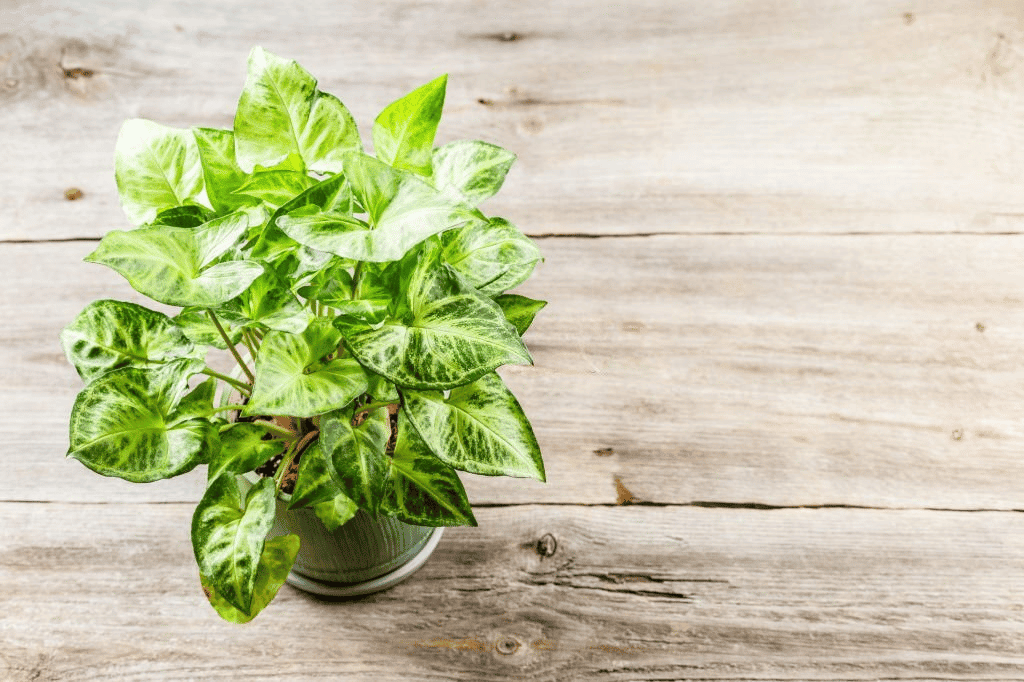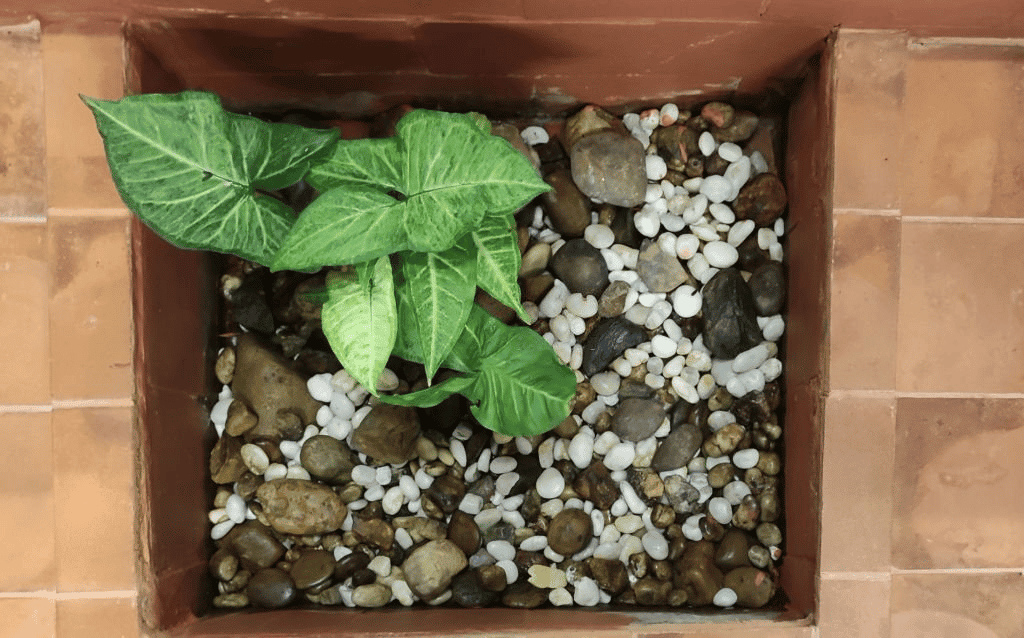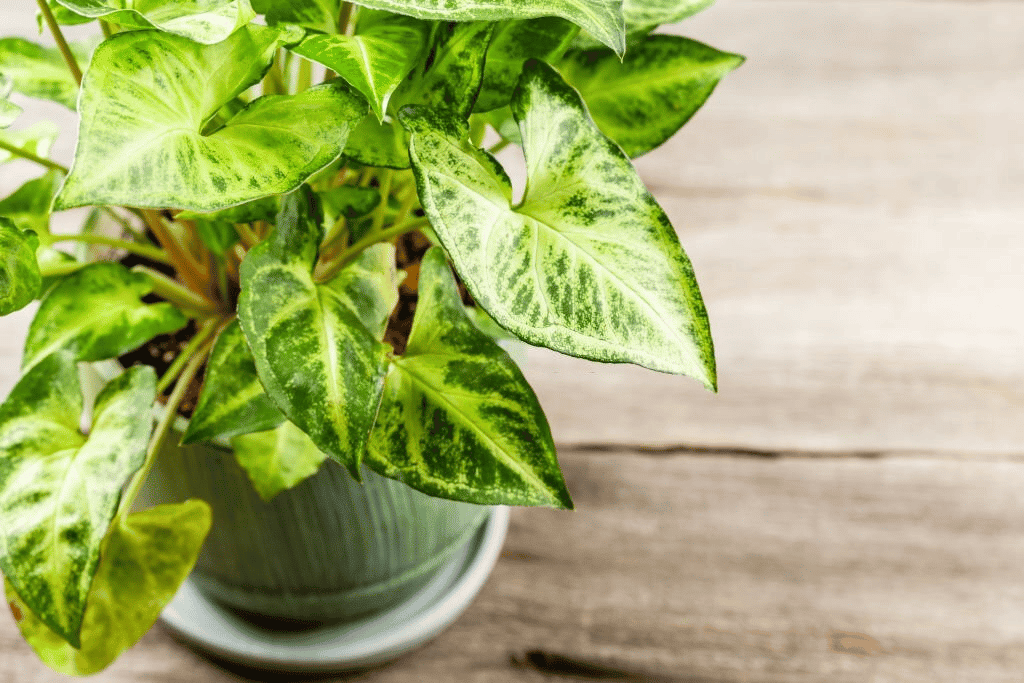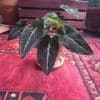The Syngonium White Butterfly is a wonderful indoor plant featuring green and white foliage. Indeed, it’s a good decorative addition to one’s home garden. But do you know the proper Syngonium White Butterfly indoor care?

Image Source: iStockPhoto
Thank you for reading this post, don't forget to the best blogger Guy About Home who offers the best garden and home improvement tips! If you are a home decor and design fan, don't miss the tips on home ideas. If you are a home garden owner, then you might be interest in our complete guides to house plants!
The Syngonium White Butterfly, or the Syngonium podophyllum, is a small plant that features white and green coloration on its leaves. Similar to cebu blue pothos, it is notable for its changing foliage as it matures. Moreover, the plant is easy to maintain. But proper care is still a must for its health and propagation.
Benefits from Syngonium White Butterfly

Image Source: iStockPhoto
Growing the Syngonium White Butterfly has some benefits. Aside from its decorative value, the plant is also linked to Feng Shui. Specifically, its five-lobed foliage is said to represent the five elements. It also symbolizes the Yin and Yang balance, which made some people believe that it is a lucky plant.
Among the less known white butterfly facts is that the plant represents beginnings, fresh ideas, and youthfulness.
The Syngonium White Butterfly is also known as the Five Fingers, White Butterfly Arrowhead, Arrowhead Vine, and American Evergreen Nephthytis. It provides diversity and induces calming ambiance in various indoor gardens.
White Butterfly Syngonium Information & Facts

Image Source: iStockPhoto
Here is the basic information about the White Butterfly Syngonium:
- Family – Araceae
- Genus – Syngonium
- Common name – White Butterfly Syngonium
- Plant type – Indoor plant; decorative houseplant
- Origin – The plant is a native species to certain parts of Latin America, specifically in Mexico and Bolivia. Eventually, the plant was domesticated in numerous places, such as Florida, Hawaii, and Texas.
- History – The White Butterfly is considered the most frequently cultivated species of the Syngonium genus. In the past, people mistook it to be similar to the Nephthytis–an African genus. In 1879, White Butterfly got its own genus.
Syngonium White Butterfly vs Syngonium White Varieties
What is the most common variety of Syngonium plants? The answer is the Syngonium podophyllum, which is the White Butterfly. Like cattleya trianae, its uniquely shaped foliage is similar to butterfly wings, which is the root of its name. But did you know that other Syngonium plants are worth checking, as well?
Syngonium White Butterfly vs. Batik
Similar to the White Butterfly, Syngonium Batik is also easy to care for and maintain. But unlike the White Butterfly, its foliage is dominated by green coloration, though its veins are still white. This particular plant also originated in the South American region, specifically in rainforests.
Notably, the Batik grows taller than the White Butterfly. It can reach up to 6 feet upon full maturity.
Syngonium White Butterfly vs. Arrowhead
Despite popular belief, the Syngonium White Butterfly is similar to the Arrowhead. They are just the same plants that use different names. But interestingly, the Arrowhead can also be coined to other species of Syngonium podophyllum, given that all of them feature arrow-shaped foliage.
Syngonium White Butterfly vs Pixie
The Syngonium Pixie, or Mini Pixie, is the dwarf version of the Podophyllum. Basically, it shares the same traits as the White Butterfly, but in a tiny form. It grows to a maximum height of 3 inches. Its origins are also in South American regions. You can grow this plant in balcony and container gardens that receive indirect sunlight.
White Butterfly Arrowhead Plant: Things to Know
Here are some of the essential details about the White Butterfly Arrowhead that you might not know yet.
Is White Butterfly Arrowhead Plant Rare?
The Syngonium Podophyllum is a common variant of the Syngonium genus. However, the White Butterfly Arrowhead plant is actually common. But due to their majestic appearance, many indoor gardeners are starting to grow them in their homes and balconies. Eventually, its rarity would soon dissipate, which is actually a good thing.
Is the Syngonium Podophyllum Indoor Plant?
Originally, the species of White Butterfly houseplant thrived in outdoor environments. You can grow this plant outdoors, but it will be susceptible to pests. Hence, many recommend making the White Butterfly Arrowhead an indoor succulent instead. Appropriate Syngonium White Butterfly care indoor care will also protect it from extreme heat and cold.
Not confident in planting an indoor plant? Why not getting power from our inspiring indoor plants quotes?
Is Syngonium White Butterfly a Trailing Plant?
Yes. This gorgeous, foliage-rich plant is a trailing plant. This is proven by its long stems that usually spill out from the pots or along the soil. The White Butterfly Arrowhead Plant doesn’t also root on the nodes of its stem. A Syngonium White Butterfly hanging on windows or balconies is one possible setup for the plant.
Is the Syngonium White Butterfly Plant Toxic?
One notable aspect of the Syngonium White Butterfly is its toxicity. Specifically, the plant can be toxic to humans due to significant levels of calcium oxalate in its body. When you ingest this, it is possible that you experience symptoms such as gastric distress, vomiting, and swelling.
Is the White Butterfly Arrowhead plant toxic to cats? Yes. The plant can be harmful to cats, dogs, and any pets in your home.
How Big Does a White Butterfly Arrowhead Plant Grow?
The Syngonium podophyllum size may vary, depending on the existing conditions in their environment.
If you grow this plant indoors, it is expected that it can grow as tall as two feet. At full maturity, the plant can have a spread of 24 inches. If grown outdoors, a foot or two could be added on its height.
Is Syngonium podophyllum a Fast-Growing Plant?
No. Even under the ideal conditions, the Syngonium podophyllum growth rate is quite slow. But how fast does it grow? Well, it takes up to ten years or more before it can reach its maturity. Hence, proper care is essential so that you can maximize its growth potential.
How to Take Care of Syngonium Podophyllum
In this section, we will teach the basics of Syngonium podophyllum care.
No worries! Though you might encounter the difficulties when learning how to care such an plant as a new plant caring starter, we got the most popular plant lover quotes that can partner with you and you are going to succeed in plant care and grow.
Besides this plant, we also make a full care guide on how to care for Swan river daisy.
White Butterfly Arrowhead Plant Light Requirements
The Syngonium White Butterfly plant doesn’t require lots of light. That’s why it is a perfect indoor place. It can grow healthily if it receives low to moderate indirect sunlight. At the same time, it can also thrive in bright environments. But ensure that you veer away from harsh sun rays to prevent its leaves from being damaged.
White Butterfly Arrowhead Plant Soil
The White Butterfly plant enjoys neutral to acidic soil. Specifically, the soil’s pH level should be around 5.5 to 8.5. Moreover, it prefers fast-draining soil because the plant doesn’t like too much moisture. Hence, the ideal potting mix for the Syngonium plant has air pockets and is well-aerated to prevent root rot.
White Butterfly Arrowhead Plant Water
Regular watering is essential for this plant. You need to water it two to three times every week, especially if it’s still young. During in-between waterings, make sure that the soil is dry. But don’t let the soil fully dry before you water the plant. Specifically, water the plant if the first two inches of the soil are already dry.
White Butterfly Arrowhead Plant Fertilizer
One should know that Syngonium is a heavy-feeding plant. This means that it requires constant fertilization for it to grow healthily. During its growing season, the plant has to receive fertilizer every two weeks. Meanwhile, the fertilizer must contain a healthy level of NPK. The plant can still grow without fertilizers, but it will be extremely slow.
How to Propagate Syngonium Podophyllum
You can do Syngonium podophyllum propagation through different means. Below is the commonly used method:
Syngonium Podophyllum Soil
Many growers tend to plant their Syngonium cuttings into the soil directly. This method is quite effective, as it prevents the plant from experiencing a shock.
When propagating White Butterfly cuttings, make sure that they include a rooting hormone in the soil. Same as aster white flower, in this way, the root of the plant develops properly. Each pot should receive up to six cuttings. Doing this would enable the Arrowhead plant to fully-spread growth.
How to Prune Syngonium Podophyllum
To keep the plant bushy, pruning is essential. It prevents the plant from being too leggy, as well.
- Pruning the plant will require you to remove up to five leaves (including their stems) from the primary stems.
- It is best that you prune the plant during summer since it encourages optimized growth.
- You may also remove old stems. The stems that you removed can be used for propagation, as well.
Syngonium White Butterfly Plant Care Problems & Leaves
The Syngonium plant isn’t impervious to problems, especially on its leaves. There are simple solutions to them, though.’
Besides this plant, we also summarize the caring issues and concerns on the plant Rose.
White Butterfly Arrowhead Plant Yellow Leaves
When the foliage of the plant turns yellow, it’s a sign that it is rooted in soil with incorrect soil moisture. Oftentimes, this is caused by overwatering. As mentioned earlier, you only need to water the first two-inch of the soil to prevent overwatering.
White Butterfly Arrowhead Plant Brown Leaves
Once the leaves of the plant turn brown, that’s a symptom of the plant being left dry for too long. If you see this happening to your White Butterfly, then it is essential to soak the soil. But don’t overwater it, either. Just pour enough water for the plant to rehydrate.
White Butterfly Arrowhead Plant Drooping
Drooping White Butterfly Arrowhead plants are pretty common. The primary culprits are under-watering and over-watering. But there are other causes that you might need to look into, such as poor lighting, wrong fertilizers, irregularities in temperature, and low indoor humidity.
How Much Does a Syngonium Podophyllum Cost
This particular plant isn’t as expensive as you might think. The Syngonium podophyllum price ranges from $5 to $10 apiece. But of course, more exotic variants may cost higher than that. Overall, the plant is affordable, so you can always get it whenever you want to.
Syngonium White Butterfly Plant Care: Summary
In a nutshell, the Syngonium White Butterfly is a great houseplant. Just as aralia fabian, it is an excellent addition to your indoor garden because of its aesthetic appeal. At the same time, some people consider the plant to be a fortune-bringer. Hence, there’s nothing wrong if you follow the care tips we listed here to ensure that your White Butterfly blooms healthily.
For more step-by-step ideas, diy tips and guides, kindly visit the website guyabouthome.com providing the best garden & home improvement tips.



